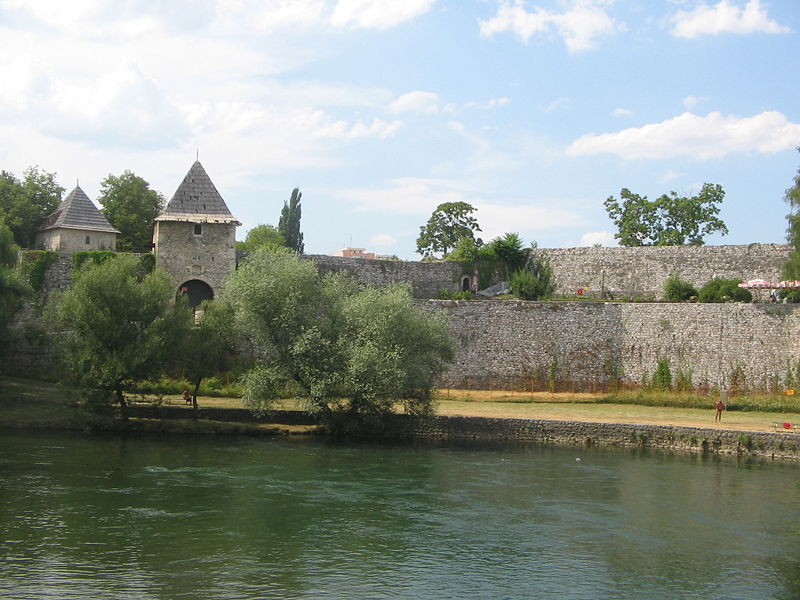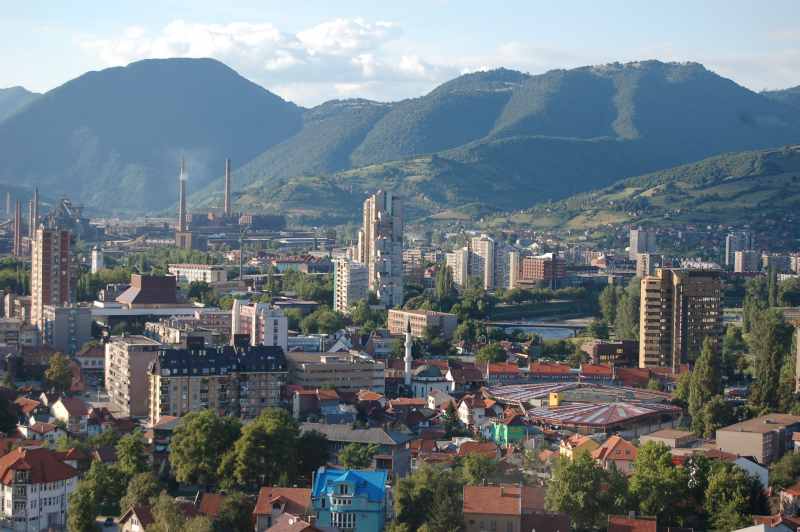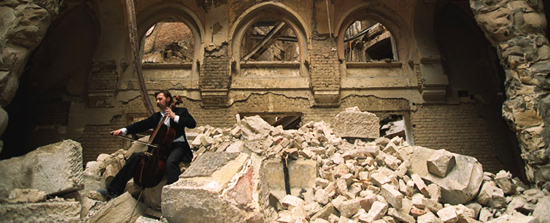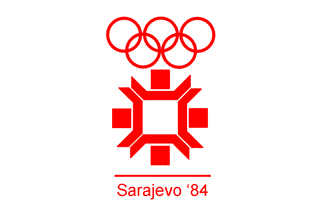My beautiful Bosnia and Herzegovina .
 •
by
•
by Sweatty
Bosnia and Herzegovina
Bosnia and Herzegovina (i/ˈbɒzniə ən hɛrtsəɡoʊˈviːnə/; Bosnian, Croatian and Serbian: Bosna i Hercegovina, Cyrillic script: Босна и Херцеговина), sometimes called Bosnia-Herzegovina, or simply Bosnia, is a country in Southeastern Europe, on the Balkan Peninsula. Its capital and largest city is Sarajevo. Bordered by Croatia to the north, west and south, Serbia to the east, and Montenegro to the southeast, Bosnia and Herzegovina is almost landlocked, except for the 20 kilometres (12 miles) of coastline on the Adriatic Sea surrounding the town of Neum.
History of Bosnia and Herzegovina
Based on archaeological evidence, he was crowned in the in Mile near Visoko in the church which was built in the time of Stephen II Kotromanić's reign, where he was also buried alongside his uncle Stjepan II.[21][22] Following his death in 1391 however, Bosnia fell into a long period of decline. The Ottoman Empire had already started its conquest of Europe and posed a major threat to the Balkans throughout the first half of the 15th century. Finally, after decades of political and social instability, the Kingdom of Bosnia ceased to exist in 1463.However, by the late 17th century the Empire's military misfortunes caught up with the country, and the conclusion of the Great Turkish War with the treaty of Karlowitz in 1699 once again made Bosnia the Empire's westernmost province. The following century was marked by further military failures, numerous revolts within Bosnia, and several outbursts of plague. The Porte's false efforts at modernizing the Ottoman state were met with distrust growing to hostility in Bosnia, where local aristocrats stood to lose much through the proposed reforms.
This, combined with frustrations over political concessions to nascent Christian states in the east, culminated in an unsuccessful revolt by Husein Gradaščević, in 1831 after the Turkish Sultan Mahmud II slaughtered and abolished the Janissary.[16] Related rebellions would be extinguished by 1850, but the situation continued to deteriorate. Later agrarian unrest eventually sparked the Herzegovinian rebellion, a widespread peasant uprising, in 1875. The conflict rapidly spread and came to involve several Balkan states and Great Powers, a situation which eventually led to the Congress of Berlin and the Treaty of Berlin in 1878.At the Congress of Berlin in 1878, the Austro-Hungarian Foreign Minister Gyula Andrássy obtained the occupation and administration of Bosnia and Herzegovina, and he also obtained the right to station garrisons in the Sanjak of Novi Pazar, which remained under Ottoman administration. The Sanjak preserved the separation of Serbia and Montenegro, and the Austro-Hungarian garrisons there would open the way for a dash to Salonika that "would bring the western half of the Balkans under permanent Austrian influence."[24] "High [Austro-Hungarian] military authorities desired [an...] immediate major expedition with Salonika as its objective."[Following the war, Bosnia and Herzegovina joined the South Slav kingdom of Serbs, Croats and Slovenes (soon renamed Yugoslavia). Political life in Bosnia at this time was marked by two major trends: social and economic unrest over property redistribution, and formation of several political parties that frequently changed coalitions and alliances with parties in other Yugoslav regions.[Once the kingdom of Yugoslavia was conquered by Nazi forces in World War II, all of Bosnia was ceded to the Independent State of Croatia. The Croat leaders embarked on a campaign of extermination of Serbs, Jews, Roma, communists and large numbers of Josip Broz Tito's Partisans by setting up a number of death camps.Though considered a political backwater of the federation for much of the 1950s and 1960s, in the 1970s a strong Bosnian political elite arose, fueled in part by Tito's leadership in the Non-Aligned Movement and Bosnians serving in Yugoslavia's diplomatic corps.
While working within the communist system, politicians such as Džemal Bijedić, Branko Mikulić and Hamdija Pozderac reinforced and protected the sovereignty of Bosnia and Herzegovina[34] Their efforts proved key during the turbulent period following Tito's death in 1980, and are today considered some of the early steps towards Bosnian independence.The Serb members of parliament, consisting mainly of the Serb Democratic Party members, abandoned the central parliament in Sarajevo, and formed the Assembly of the Serb People of Bosnia and Herzegovina on 24 October 1991, which marked the end of the tri-ethnic coalition that governed after the elections in 1990. This Assembly established the Serbian Republic of Bosnia and Herzegovina on 9 January 1992, which became Republika Srpska in August 1992.
On 18 November 1991, the party branch in Bosnia and Herzegovina of the ruling party in the Republic of Croatia, the Croatian Democratic Union (HDZ), proclaimed the existence of the Croatian Community of Herzeg-Bosnia, as a separate "political, cultural, economic and territorial whole", on the territory of Bosnia and Herzegovina, with Croat Defence Council (HVO) as its military part.[36] The Bosnian government did not recognize it. The Constitutional Court of Bosnia and Herzegovina declared Herzeg-Bosnia illegal, first on 14 September 1992 and again on 20 January 1994.[37][






Geography of Bosnia and Herzegovina
The country's name comes from the two regions Bosnia and Herzegovina, which have a very vaguely defined border between them. Bosnia occupies the northern areas which are roughly four fifths of the entire country, while Herzegovina occupies the rest in the south part of the country.
The country is mostly mountainous, encompassing the central Dinaric Alps. The northeastern parts reach into the Pannonian basin, while in the south it borders the Adriatic. Dinaric Alps generally run in east-west direction, and get higher towards the south. The highest point of the country is peak Maglić at 2,386 m, at the Montenegrin border. Major mountains include Kozara, Grmeč, Vlašić, Čvrsnica, Prenj, Romanija, Jahorina, Bjelašnica and Treskavica.
Overall, close to 50% of Bosnia and Herzegovina is forested. Most forest areas are in Cetral, Eastern and Western parts of Bosnia




Demographics of Bosnia and Herzegovina
According to the 1991 census, Bosnia and Herzegovina had a population of 4,377,000, while the 1996 UNHCR unofficial census showed a decrease to 3,920,000.[citation needed] Large population migrations during the Yugoslav wars in the 1990s have caused demographic shifts in the country. No census has been taken since 1991/96, and political disagreements have made it impossible to organize one. Nevertheless, a census has been planned for 2012

Largest cities of Bosnia and Herzegovina
Sarajevo

Banja Luka

Tuzla

Zenica

Mostar

Architecture of Bosnia and Herzegovina
The architecture of Bosnia and Herzegovina is largely influenced by four major periods where political and social changes influenced the creation of distinct cultural and architectural habits of the population. Each period made its influence felt and contributed to a greater diversity of cultures and architectural language in this region.

Literature of Bosnia and Herzegovina
Bosnia and Herzegovina has a rich literature, including a Nobel prize winner Ivo Andrić and poets such as Antun Branko Šimić, Aleksa Šantić, Jovan Dučić and Mak Dizdar, writers such as Meša Selimović, Semezdin Mehmedinović, Miljenko Jergović, Isak Samokovlija, Safvet beg Bašagić, Abdulah Sidran, Petar Kočić, Aleksandar Hemon, and Nedžad Ibrišimović. The National Theater was founded 1919 in Sarajevo and its first director was famous drama-play writer Branislav Nušić. Magazines such as Novi Plamen, Most and Sarajevske biljeznice are some of the more prominent publications covering cultural and literary themes.

Art of Bosnia and Herzegovina
The art of Bosnia and Herzegovina was always evolving and ranged from the original medieval tombstones called Stećci to paintings in Kotromanić court. However, only with the arrival of Austro-Hungarians did the painting renaissance in Bosnia really begin to flourish. The first educated artists from European academies appeared with the beginning of 20th century. Among those are: Gabrijel Jurkić, Petar Tiješić, Karlo Mijić, Špiro Bocarić, Petar Šain, Đoko Mazalić, Roman Petrović and Lazar Drljača. Later, artists such as: Ismet Mujezinović, Vojo Dimitrijević, Ivo Šeremet, and Mica Todorović amongst others came to rise. After World War II artists like: Virgilije Nevjestić, Bekir Misirlić, Ljubo Lah, Meho Sefić, Franjo Likar, Mersad Berber, Ibrahim Ljubović, Dževad Hozo, Afan Ramić, Safet Zec, Ismar Mujezinović and Mehmed Zaimović rose in popularity. In 2007, Ars Aevi, a museum of contemporary art that includes works by renowned world artists was founded in Sarajevo.

Music of Bosnia and Herzegovina
Typical Bosnian and Herzegovinian songs are ganga, rera, and the traditional slavic music for the folk dances such as kolo and from Ottoman era the most popular is sevdalinka. Pop and Rock music has a tradition here as well, with the more famous musicians including Dino Zonić, Goran Bregović, Davorin Popović, Kemal Monteno, Zdravko Čolić, Edo Maajka,Hari Varesanovic and Dino Merlin

Cinema
Bosnia has a rich cinematic and film heritage, dating back to the Kingdom of Yugoslavia; many Bosnian filmmakers have achieved international prominence and most have won international awards ranging from the Academy Awards to multiple Palme d'Ors and Golden Bears. Some notable Bosnian filmmakers, screenwriters and cinematographers are Academy Award-winner Danis Tanović (known for the Academy Award– and Golden Globe–winning 2001 film No Man's Land), Golden Bear-winning Jasmila Žbanić, Hajrudin Krvavac-Šiba, Mirza Idrizović, Aleksandar Jevđević, Ivica Matić, Ademir Kenović, the late Benjamin Filipović, Jasmin Dizdar, Pjer Žalica, Dino Mustafić, Srđan Vuletić, Aida Begić, among many others.
Sports
The Borac handball club has won seven Yugoslav Handball Championships, as well as the European Championship Cup in 1976 and the International Handball Federation Cup in 1991.
The Bosna basketball club from Sarajevo were European Champions in 1979. The Yugoslav national basketball team, which medaled in every world championship from 1963 through 1990, included Bosnian players such as Dražen Dalipagić and Mirza Delibašić. Bosnia and Herzegovina regularly qualifies for the European Championship in Basketball. Jedinstvo Aida women's basketball club, based in Tuzla, has won the 1989 European Championships in Florence.
The Tuzla-Sinalco karate club from Tuzla has won the most Yugoslav championships, as well as four European Championships and one World Championship.Today, the team of Bosnia and Herzegovina has modern footballers like Edin Džeko, Zvjezdan Misimović, Vedad Ibišević, Emir Spahić, Asmir Begović, Miralem Pjanić, Sejad Salihović and others. The independent Bosnia and Herzegovina national football team has not qualified for a European or World Championship but has played twice in the play-off stages. For all time matches: Bosnia and Herzegovina national football team results (1995-2011).


Bosnia and Herzegovina cuisine
Bosnian cuisine uses many spices, in moderate quantities. Most dishes are light, as they are cooked in lots of water; the sauces are fully natural, consisting of little more than the natural juices of the vegetables in the dish. Typical ingredients include tomatoes, potatoes, onions, garlic, peppers, cucumbers, carrots, cabbage, mushrooms, spinach, zucchini, dried beans, fresh beans, plums, milk, paprika and cream called Pavlaka. Bosnian cuisine is balanced between Western and Eastern influences

Flag of Bosnia and Herzegovina

and at the end of one vote and subscribers


Comments
ima tuzla ima vote imaju cevapi ima vote 2x
v
odlično sve
BIG VOTE 😉
V25 S12
Ko nezna,vrati!
http://www.erepublik.com/en/article/predstavljanje-113-scaron-ibenske-brigade-2020835/1/20
vote
Ima BOSNa ima vote 😃...
Interesantan clanak, ali ti se potkrala greska. Naime, medju slike BiH gradova stavio si i sliku Banjaluke, glavnog grada susjedne Republike Srpske ... Ispravi to i imas vote
A gle Neuma, "bosansko more", xaxaxaxa!
A i Mostar je tu, oličje multietnićnosti BiH... : )
dobar članak...protecteur - Republika Srpska je entitet u državi Bosni i Hercegovini, dio BiH a Banja Luka je jedan od ljepših Bosanskih gradova.....vidiš da je dobar članak možeš nešto novo da naučiš, stavi vote obavezno 😉
Bosanski arslane
Republika Srpska je zasebna drzava koja je zbog potrebe da neko u Vasingtonu kaze " Evo, jel mogu ja da budem direktor, ja sam zaustavio rat i napravio drzavu BiH" prisiljena da funcionise u labavom zajednistvu sa Muslimansko-Hrvatskom Federacijom. To ako ne znas, slabo te uce istoriju u skoli, obavezno pitaj svog babu da ti rastumaci, zna on garant...
v. Svaka cast za ovo!
@liku sa pedofilskim avatarom:
republika smrdska moze samo birat kako ce nestat...nista drugo joj nece biti u opticaju.
Ponosan Bosanac
sto se tice pedofilije, mislim da Ajsa o tome najbolje zna...
Dalje, iskreno se nadam da ce Sedma muslimanska internet brigada da krene sa konkretnim akcijama, ove prijetnje i sitne prozivke djeluju kao da ste se pomirili sa cinjenicom da ce "bit Bosne" , al do Tuzle xD
@protecteur
Vi ste bili Bošnjani pravoslavci do 1844 dok nije napisan dokument od strane Ilije Garašina zvana Načrtanije. Vjerovatno si je već čitao jer se tu prvi put zagovara ideja velike srbije. Tu ćeš vidjeti iz srpske glave kako vas nazivaju "Bošnjane naše vere", a pored njih su bili katolici i muslimani, to jeste prije katari patareni ili ti ga Bogomili. SVI SU ONI BILI DOBRI BOŠNJANI.
voted! A prije dva dana sam sanjala ove gore cevape s lukom i kajmakom 😛 (jedva cekam sutra, da sletim u SA, dodjem na nasu lijepu Bascarsiju, te pojedem cevape 😛)
Vi ste izdali svoju domovinu i uzeli nacionalnost susjedne nam države.
Što se tiče bitke na kosovu, lijevo krilo vojske je bilo sačinjeno od bosanskih vitezova koje je predvodio Vlatko Vuković, a njega je poslao BOSANSKI kralj TVRTKO jer se u to doba pomirio sa Žigmundom ugarskim kraljem koji je tražio pomoć. Pored njih borili su se i hrvatski križari pod vodstvom bana Ivaniša Horvata. Nisu se samo srbi ginuli i na kosovu se borili 😉
v+s
protectur
sto se ne oCjepite hahahahahahahahahahahaha : D
ljiljan89
ajd na teheran x na temu o preCjedniku, tamo ti je mjesto....
RPGvsTENK
Ne ulazeci u debatu o nacionalnoj i vjerskoj pripadnosti Tvrtkovoj, samo cu ti napomenuti da je Bosna regionalna odrednica, i da su tada postojale i npr Raska, Zeta, Trebinje je bilo zasebno, Dubrovnik zaseban... Kako to bem mu led da odjednom samo bosna ima "tisucljetnu drzavnost"???? Drugo, taj isti Tvrtko je tuko Turke gdje je stigao, a odjednom vi, "dobri bosnjani", kunete se u "majku tursku"???
v+s dobar članak prijatelju šteta samo što ga neki kao protecteur kvare komentarima koji su nebitni ,Bosne je bilo i bice je zauvijek kao i nas u njoj ,svaka čast ponovo na članku i samo tako nastavi...🙂
HAIL Sweatty
HAIL eBiH
radovlje
ne znam na osnovu cega mozes biti tako siguran, jer su mnoge vece rijeke presusile, pa tako moze i rijeka Bosna da presusi.... Al svaka cast ipak, optimizam imas za svaku pohvalu...
Optimizam baziram na historijskim činjenicama da su preko nas pregazili iliri,rimljani,osmansko carstvo,austrougarska monarhija, prvi svjetski rat,drugi svjetski rat pa i ovaj zadnji a mi smo još tu i bićemo zauvijek (eto ti osnov 😛)
vi ste bolan Srbi, koji ste prvo bili mnogobosci, pa ste onda bili pravoslavci/katolici, pa je onda najveci sljam uzeo tursku vjeru, da moze da nosa fes po carsiji dok "raja" od koje je pobjegao gladuje... Neki istoricari vas prelazak na islam opisuju kao neku vrstu klistira srpske nacije... Sve sto ne valja je otislo... Slabo vas uce u tim skolama, jedino vasi sunarodnjaci iz OS "Petar Petrovic Njegos" Srebrenica nesto znaju, vi ostali pojma nemate...
protecteur idi bre srci pesak u beogradu ili odi sa hercegovcima tucaj kamen u sirokom brigu 😛
btw vote pogotovo za Banja Luku !
http://www.youtube.com/watch?v=U1JUBc-AFKo
http://www.youtube.com/watch?v=v_uIAPnLLAY
@protecteur Ne seri idi u Srbiji ako ti se ne dopada BiH i pusti se tih RL frustracija ovo je igra
blazina
Beograd je meni jednako drag i jednako blizak kao Banjaluka.. Banjaluka i Beograd su glavni gradovi dvije srpske drzave, i kao takvi su najljepsi na svijetu....
Sto se tice Sirokog Brijega, to je dio HercegBosne, i jedina poveznica Srba iz RS i Sirokog Brijega su orbit zvake...
Tako da, nemoj mene da tjeras nigdje, ja sam svoj na svome, pitanje je da li si ti??
Hahah ma ta "velika"srbija postaje mala srbija
I takvi ko ti tjerate u propast ovu drzavu
http://www.braniteljski-portal.hr/files/portal/velika_srbija_1_.gif
Zvix
ja mogu da razumijem ovu kartu, jer ti garant sluzi da zavaras sam sebe kada se vozis kroz Sarajevo, pa skontas da na raskrsnici u Dobrinji odjednom pocinje druga drzava... Jbg, ja u neku ruku mogu i da saosjecam s tobom, nije ti lako, obecana vam je cijela BiH i zlatne kasike, a ono Srbi i dalje na planinama oko Sarajeva xD
Imam savjet, ako ti ikad dodje da puknes sto Srbe bas nesto zabole za BiH, a ti na ovoj karti izbrisi i Vojvodinu, bice ti valjda lakse....
Ma mene brige i da se izbrise meni je samo pun kurac takvih ko tebe koji se sigurno samo druzi sa srbima ,a mi barem is SA i drugih gradva smo multnietnicka nacija ne ko ti koji bi sigurno opet poceo rat da se mozes samo druziti s svojim JADNO
Ja nemam nijednog prijatelja crnca... Jel to znaci da sam clan KKK????
A jel jedan od tih tvojih drugara "Srba" "cika Jovo" Divjak mozda??
Zanimljivo kako nekima ovde istorija (historija, povijest) počinje u kasnom srednjem veku, a preskačete kraljeve Srbe, Vladisavljeviće, lozu Svetog Jovana Vladislava. Vrati se sebi dok još imaš kome
svaka cast super text.
v+s
protecteur ja sam SVOJ NA SVOME!
Sa moje djedovine nitko mene ne može istjerati niti karadžić ni mladic niti bilo koji drugi zlocinac..
' Volim sve ljude dobre volje ali izdali ste nas komšije i to vam zaboravit nećemo (svaka čast onima koji su drukčije razmišljali a ne kao ovce slušali ratne zločince Mladića i Karadžića)! Republika srpska ne postoji i nikad neće postojati. Na kraju uvijek pobijedi dobro a vi zlotvori čuvajte se gnjeva Božijeg i njegova malja.'
ljudi sta se ba primate... vidite da je covjeku krivo sto mu na pasosu pise BiH xD
pustite ga, smirice se on 🙂
@tip sa pedofilskim avatarom
E moj jarane, praunuce Turskog okupatora, po tvom misljenju su i oni majmuni prije nekoliko hiljada godina bili srbi... sve je moguce, al ocito da ta sorta nikad nije silazila sa drveta, pa su zauvjek ostali, majmuni.
@liku sa pedofilskim avatarom:
Cekamo, da vidimo tu nezavisnu republiku, pa da krenemo...Vjerujem da vam je to smrtna kazna. Ne samo smrdskoj nego i vecini smrdova.
Svi vi koji negirate bosansku državu, mogu samo da vam kažem da niste normalni i pored svih dokaza da je BOSNA postojala kao zasebna. Srpski i hrvatski historičari smatraju da Srednjovjekovna bosanska država stiče svoju nezavisnost oko 1200. godine, zasnivajući svoje teze na osnovu nepotvrđenih dokumenata katoličke i pravoslavne crkve, te da se u ovom periodu razvija njen autohtoni BOŠNJANSKI narod. Mada bosanski historičari smatraju da je Bosna samostalna država jos od 9. vijeka.
HVALA TJAO
Ima tuzla ima vote imaju cevapi ima vote x2
Ovo je samo "istočna Tuzla" ima još s druge strane "zapadna Tuzla" ako je tako mogu podjeliti. Ovo su Bulevar, Stupine i Brčanska čak se ni Sjenjak ni Slavinovići ne vide. : D
Nemojte se svađati sa @likom sa pedofilskim avatarom. Jer on je dio "nebeskog naroda". A to su rijetki vjerujte. A sad nešto što vrijedi više od čitave srbije:
http://bljesak.info/web/article.aspx?a=7435e4e3-1632-4681-b9a5-891cd0cd3a19&c=5de70792-d2d5-4648-8125-5206af0d3357 x D
vote i sub za isticanje naših ljepota, a "haters gonna hate"
sta ovo kradu gradove iz druge drzave..cccc
Vratit ce se POSAVINA...
R. SRPSKA CELA IZ DVA DELA
RASPOLUTILA SE JADNA KOLIKO JE TRUHLA
OVO DA SE UBACI U TUTORIJAL ZA RAJU IZ "BOLJEG DIJELA BIH"
Haj odkako je Banja Luka postala,haj nije ljepša udovica postala 🙂
koji kurac se svađate sa protecteurom?
nek fura svoj fazon vidite da još ni u školu nije kreno a daju mu za komp sjest
RPGvsTENK objasnio pravoslavnom bosnjaninu kako je okrenuo ledja domovini.
svaka daljna rasprava sa ovim izdajnickim smecem je nepotrebna...ne mozes hajvanu objasnit nista.
jebali mu turci majku i izgubio identitet
2012 majmuni
Samo da se razjasni .... :
Do dolaska Turaka na Balkan Bosna je bila srpska zemlja . Dolaskom Turaka pocela je islamizacija Srba , nisu se Turci doselili u Bosnu . Svi bošnjaci danas su nastali od Srba . To je istorija koja se ne može izmijeniti . Ovim komentarom ne želim nikoga da vrijeđam , samo govorim istorijsku istinu !